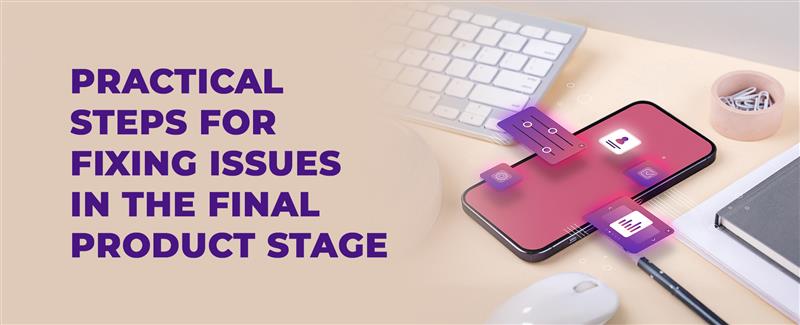Practical Steps for Fixing Issues in the Final Product Stage
11 Jul 25 


You’ve worked on your product for months. Everything seemed perfect. Your launch date is next week. Then someone finds a bug that crashes everything. This is every product team’s worst nightmare.
Even the biggest companies face last-minute problems. The difference between success and failure isn’t avoiding these issues – it’s knowing how to handle them when they come up. Let’s explore through this blog how to fix the issues in the final product stage.
Why Last-Minute Problems Feel So Scary
Problems at the end feel different from regular bugs. They’re scarier because time is running out, everyone is watching, the pressure is huge, and one wrong move could ruin everything.
These problems often happen because small issues built up over time. Or maybe your product works differently in the real world than in testing. Sometimes users do things you never expected. Maybe they’re using older browsers, slower internet connections, or combining features in ways you didn’t think about.
Take a deep breath and follow a plan. Every successful product team has been through this exact situation before.
Read Top 5 Key Trends For Cost – Effective Mobile App Development
Step 1: Sort Your Problems by How Bad They Are
When multiple things go wrong at once, you need to figure out what to fix first. Not all problems are equal. Think of it like a hospital emergency room – doctors don’t treat everyone in the order they arrive. They treat the most serious cases first.
Make three lists:
✔️Must Fix Now – Things that completely break your product or create serious security risks
✔️Should Fix Soon – Problems that make your product harder to use but don’t break it
✔️Can Wait – Nice improvements that aren’t urgent
For each problem, write down what causes it to happen, how often it happens, who it affects, and what happens to your business if you don’t fix it. This isn’t busy work, it’s the foundation for making smart decisions under pressure. You’ll be surprised how many problems that seemed critical at first glance actually fall into the “can wait” category.
Pick one person to make the final decisions about what gets fixed. Too many people making choices leads to confusion and delays. Choose someone who understands both the technical side and the business side of your product. This person needs to be able to say “no” to fixing certain things, even when people are passionate about them.
The hardest part of triage is being honest about what you can actually accomplish. If you have three days left and five critical problems, you need to accept that some things might not get fixed before launch. This reality check is painful but necessary.
Step 2: Set Up Your Command Center
You need one place where everyone working on fixes can communicate. This could be a physical room, a video call, or online chat channels. Think of it as your mission control center where all the important decisions happen.
Create separate chat rooms for different types of problems. This stops people from getting overwhelmed with too much information. One channel for critical bugs, another for performance issues, and maybe a third for general coordination. Pin important information at the top of each channel so new people can get up to speed quickly.
Have short team meetings every few hours to check on progress. Keep these meetings focused on what’s been fixed, what’s still broken, who needs help, and what should we work on next. Set a timer for these meetings – they should never go longer than 15 minutes. If something needs more discussion, take it offline with the specific people involved.
Write everything down in a shared document that everyone can see. Use a simple format that includes the problem description, current status, who’s working on it, when it should be done, and what other work depends on this. Update this document constantly because old information is worse than no information during a crisis. Consider using a simple spreadsheet or project management tool that everyone can access easily.
Step 3: Learn When Quick Fixes Are Okay
Not every problem needs a perfect solution. Sometimes a band-aid fix that works right now is better than a perfect fix that takes too long. This goes against everything you learned about proper coding and design, but crisis mode has different rules.
For problems that completely break your product, focus on making it work again. You can make it better after launch. The goal is to get your product functional, not perfect. Perfect is the enemy of good when you’re under time pressure.
For less serious problems, think about temporary solutions. Can you turn off a broken feature for now? Can you add a warning message to help users avoid the problem? Can you change how something looks to hide the issue? Can you simplify a complex workflow that’s causing problems?
These aren’t perfect solutions, but they buy you time to fix things properly later. Think of them as putting a cast on a broken arm – it’s not permanent, but it lets you function while the real healing happens. Document every temporary fix you implement so you can come back and improve them later.
If you use temporary fixes, set up alerts to tell you if they stop working. You need to know immediately so you can respond fast. Create a list of all temporary fixes and schedule time after launch to address them properly.
Step 4: Get the Right People on the Right Problems
Crisis time often means pulling people from other projects. Do this smart, not desperate. Find your most flexible team members – people who can switch between different types of problems easily. These are your crisis heroes, but don’t burn them out by giving them every problem.
Create small teams for different types of problems. One team handles critical bugs, another works on performance issues, and another focuses on user experience problems. This stops people from jumping between different types of work, which slows everyone down and creates confusion.
Consider bringing in outside help if you have the budget. Sometimes a fresh pair of eyes can spot problems that your team has been staring at for too long. Contractors or consultants who specialize in crisis situations can be worth their weight in gold.
Protect your team from outside pressure. Have one person handle all the status updates and questions from bosses and stakeholders. This lets your technical team focus on actually fixing things instead of constantly explaining what they’re doing. Choose someone who’s good at managing up and can keep stakeholders informed without overwhelming them with technical details.
Step 5: Test Your Fixes Without Breaking More Things
Your normal testing process probably won’t work in crisis mode, but you still need to make sure fixes actually work. Focus on quick tests that check the most important features. Don’t try to test everything – just test enough to make sure you didn’t break anything major.
Create a simplified testing checklist that covers the core functions of your product. This should be something any team member can run through in 15-20 minutes. Focus on the user paths that generate the most business value or affect the most users.
Use feature flags or similar tools to roll out fixes slowly. Test with a small group first, then expand to everyone. If something goes wrong, you can quickly turn it off. This approach lets you be more aggressive with fixes because you have a safety net.
Set up a testing environment that’s as close to your real product as possible. This gives you a safe place to test fixes before they go live. If you don’t have a proper staging environment, create one now – even a basic one is better than testing directly in production.
Also read A Complete Guide To Mobile App Testing: Types And Benefits
Step 6: Keep Everyone in the Loop
When things are going wrong, communication becomes even more important. People need to know what’s happening, but they also need to trust that you’re handling it. Send updates to key stakeholders every day. For really serious problems, you might need to update them more often.
Be honest about timelines and choices. If fixing one problem means delaying your launch, explain what that means. If you’re using a temporary solution, explain what that means for the future. People can handle bad news better than they can handle surprises.
Create different communication strategies for different audiences. Your developers need different updates than your marketing team. Develop your messages to what each group needs to know.
Prepare people for potential problems after launch because if you’re using quick fixes, there’s a higher chance of unexpected issues later. Set expectations now so people aren’t surprised if something goes wrong after you ship.
Step 7: Support Your Team Through the Crisis
Crisis mode is stressful for everyone. People work long hours, make tough decisions, and deal with a lot of pressure. Taking care of your team isn’t just the right thing to do – it’s also practical because tired, stressed people make more mistakes.
Make sure people take breaks, even short ones. Encourage them to step away from their computers, get some fresh air, or grab a snack. Order food for the team if people are working late. These small gestures make a big difference in morale.
Celebrate small wins along the way. When someone fixes a problem, acknowledge it. When the team hits a milestone, take a moment to recognize the progress. During a crisis, it’s easy to focus only on what’s still broken and forget about what’s already been fixed.
Watch for signs of burnout or emotional overload. Some people handle stress better than others. If someone seems overwhelmed, check in with them privately. Maybe they need to switch to a different task or take a longer break.
After the crisis is over, give your team time to recover. Consider giving people a day off or reducing their workload for a while. They’ve been through a lot, and they need time to recharge. Plan a team celebration once everything is settled.
When to Delay Your Launch
Sometimes the best choice is to delay your launch. This is a hard decision, but sometimes it’s the right one. Consider delaying if you have critical bugs that make your product dangerous or unusable, if fixing the problems would require so many temporary solutions that your product becomes unstable, if the problems affect a large percentage of your users, or if you don’t have confidence that your fixes will work.
Think about your reputation and long-term success. A delayed launch might disappoint people in the short term, but a broken product can damage your reputation for years. Consider the cost of customer support, refunds, and lost trust versus the cost of a delay.
Remember, it’s better to launch a week late with a working product than to launch on time with a broken one. Your users will forgive a delay, but they won’t forgive a product that doesn’t work. Some of the most successful products in history were delayed multiple times before launch.
Plan for After the Crisis
Once you’ve handled the immediate problems, take time to understand what went wrong and how to prevent it next time. Have a team meeting to discuss what warning signs you missed, what you could have caught earlier, and how you can build better safety nets.
Focus on improving your process, not blaming people. Everyone was doing their best under pressure. Ask questions like: What testing could we have done earlier? What communication could have been better? What tools or processes would have helped us move faster?
Write down what you learned. What worked well during the crisis? What didn’t? Create a guide for handling future problems based on this experience. Include contact information for external resources, templates for communication, and checklists for common crisis scenarios.
Review your temporary fixes and schedule time to implement proper solutions. Don’t let technical debt pile up just because you survived the crisis. Plan to address these issues in your next development cycle.
The Long-Term View
Handling last-minute problems well is a skill that gets better with practice. The more you understand your product, your team, and your processes, the better you’ll get at managing these situations. Every crisis teaches you something valuable about testing, communication, or spotting warning signs sooner.
These lessons make your next product launch smoother and your team stronger. You’ll develop better instincts for what problems are really critical versus what just seems scary. You’ll get better at estimating how long fixes will take. You’ll build stronger relationships with your team members.
Your product might not launch exactly as planned, but with the right response, it can still be successful. Many great products had rocky starts but became huge successes because their teams knew how to handle problems effectively. The companies that survive and thrive are the ones that can adapt quickly when things go wrong.
The next time you face a last-minute crisis, remember that you’ve got this. Follow the steps, trust your team, and focus on solving one problem at a time. Before you know it, you’ll be celebrating a successful launch with valuable lessons learned along the way.
Follow us for more practical steps and insights.
- Agentic AI1
- Android Development3
- Artificial Intelligence35
- Classified App3
- Custom App Development5
- Digital Transformation12
- Doctor Appointment Booking App14
- Dropshipping1
- Ecommerce Apps40
- Education Apps2
- Fintech-Apps37
- Fitness App4
- Flutter4
- Flutter Apps20
- Food Delivery App5
- Grocery App Development1
- Grocery Apps3
- Health Care10
- IoT2
- Loyalty Programs9
- Matrimony Apps1
- Microsoft1
- Mobile App Maintenance2
- Mobile Apps129
- Product Engineering6
- Progressive Web Apps1
- React Native Apps2
- Saas Application2
- Shopify9
- Software Development3
- Taxi Booking Apps7
- Truck Booking App5
- UI UX Design8
- Uncategorized6
- Web App Development1



















Comments